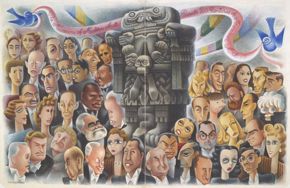Paint the USA: A Time Line of “Mexican Modernism” Artists in America July 26, 2017

Miguel Covarrubias, Twenty Centuries of Mexican Art at the Museum of Modern Art, 1940, watercolor, Yale University Art Gallery, New Haven, Connecticut, gift of Sra. Rosa R. de Covarrubias. © Maria Elena Rico Covarrubias
This illustration for a 1940 issue of Vogue magazine offers a sly take on the popularity of Mexican culture in the United States.
José Clemente Orozco’s mural Epic of American Civilization is digitally re-created in the galleries of Paint the Revolution: Mexican Modernism, 1910–1950.
Alfredo Ramos Martínez, Zapatistas, c. 1932, oil on canvas, San Francisco Museum of Modern Art, Albert M. Bender Collection, gift of Albert M. Bender. © The Alfredo Ramos Martínez Research Project, reproduced by permission
Frida Kahlo, Self-Portrait on the Border Line between Mexico and the United States, 1932, oil on metal, collection of María and Manuel Reyero, New York. © 2017 Banco de México Diego Rivera Frida Kahlo Museums Trust, Mexico D. F. / Artists Rights Society (ARS), New York
Diego Rivera, Dance in Tehuantepec, 1928, oil on canvas, collection of Eduardo F. Costantini, Buenos Aires. © Banco de México Diego Rivera Frida Kahlo Museums Trust, Mexico D.F. / Artists Rights Society (ARS), New York
David Alfaro Siqueiros’s mural Portrait of the Bourgeoisie (1939–40), painted for the electrician’s union headquarters in Mexico City, is digitally re-created in the galleries of Paint the Revolution: Mexican Modernism, 1910–1950.
What do Frida Kahlo, José Clemente Orozco, Diego Rivera, and David Alfaro Siqueiros have in common? They’re some of modern art’s most famous artists—and all left their native country of Mexico to live and work in the United States for a time.
In the 1920s and 1930s, Mexico captivated the United States, as both an ancient wellspring of culture and a source of sensational new artistic developments. A strong support network and market for their art drew prominent Mexican painters northward.
Here’s a brief time line of modern Mexican artists in the United States who, in fresco as well as on canvas and paper, looked at Anglo-America from the viewpoint of Latin America:
1927
Lacking prospects in Mexico City, José Clemente Orozco departs for New York. At Dartmouth College in New Hampshire in 1934, Orozco completes The Epic of American Civilization—a mural which Houston audiences can now see digitally re-created in the galleries of Paint the Revolution: Mexican Modernism, 1910–1950—before moving back to Mexico the following year.
1929
Alfredo Ramos Martínez immigrates to Los Angeles, where he gains a following among collectors and institutions for his depictions of a picturesque world of Mexican life. Ramos Martínez would live the rest of his life in California.
1930
Diego Rivera and Frida Kahlo arrive in San Francisco. They would go on to live in New York City and Detroit as well, before returning to Mexico in late 1933. Rivera enjoys success when his solo exhibition opens at the Museum of Modern Art in New York in 1931, and two years later, he completes his own favorite work, the Detroit Industry Murals at the Detroit Institute of Arts. Meanwhile, Kahlo is ambivalent about her U.S. experiences: She paints herself between two worlds in Self-Portrait on the Border Line between Mexico and the United States, on view in Paint the Revolution.
1932
David Alfaro Siqueiros moves to Los Angeles and paints America Tropical, a public mural that is partially, then completely covered with whitewash to hide its controversial political content. His stay is a short one, as his visa runs out and he returns to Mexico after a few months.
See work by these artists and learn more in the exhibition “Paint the Revolution: Mexican Modernism, 1910–1950,” on view in the Law Building through October 1.





